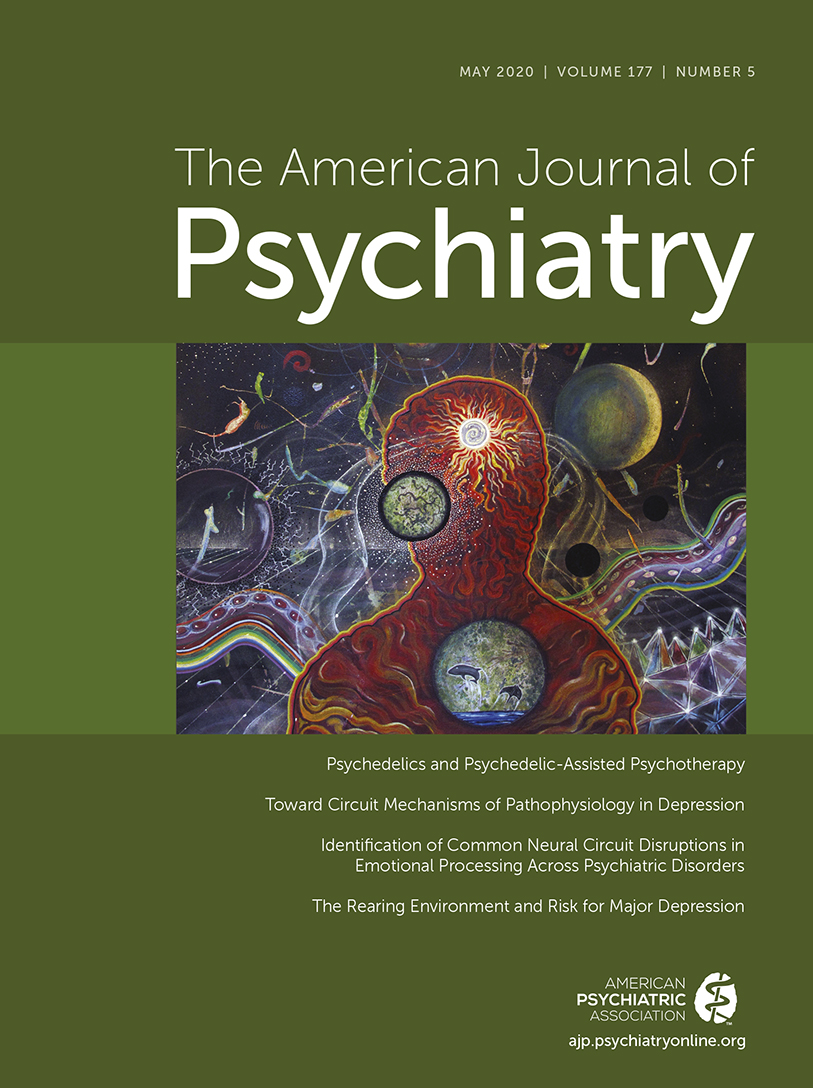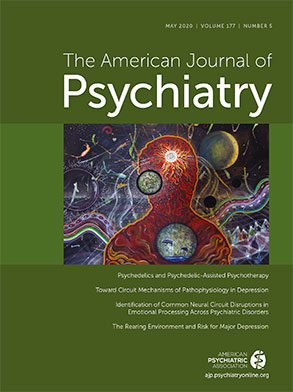I’ve increasingly felt that the correct answer to the question “Is depression nature or nurture?” is “yes.” In a landmark study in this issue, Kendler and colleagues (
1) put substance to this answer. While the answer may still be “yes,” through the use of a cleverly designed natural experiment, Kendler et al. have identified a portion of nurture, the rearing environment, that can clearly be defined and even altered with intervention. In brief, they studied 666 high-risk full siblings, with high risk defined as having at least one parent with major depression, and 2,595 high-risk half siblings of which at least one was home-reared and one adopted away. What made this study possible were the large samples from a national registry in Sweden, the parental assessments, and the fact that in Sweden, where adoption is not common, adoptive families are selected to provide high-quality rearing environments, including high educational status, economic security, and a stable environment.
It is impressive that this study comes from an investigator group that has done major genetic and twin studies. In both types of studies, the nature of the environment is unclear. Similarly, the adoption studies, another way of studying environmental effects, usually have had insufficient information on the biological parents and their clinical state. As the authors point out, biological parents of adoptees likely have a higher risk of psychopathology, less education, and higher divorce rates. Moreover, the environment in the adopted-away home has not been clearly defined in most studies. In fact, the authors previously carried out an extended adoption study in the same sample and had shown statistically that genetic factors and rearing experiences contributed to an approximately equal extent (
2). Both forms of cross-generational transmission act additively on the risk for depression in the offspring. However, the contribution of the rearing environment was only shown statistically. These challenges in this and other previous reports must have led the authors to this study design.
The findings confirmed the strong protective effect of a nurturing rearing environment on the child’s well-being. However, this protective effect disappeared when an adoptive parent had major depression or the nurturing adoptive home was disrupted by parental death or divorce during the adoptee’s childhood or adolescence. The results demonstrate the strong impact of the rearing environment on risk for major depression and support the importance of intervention efforts to improve the rearing environment in high-risk families.
In other research, which the authors note, there is confirmatory evidence of the effects on children of alterations in a parental depressive status. Several studies have shown the positive effects on offspring of successful treatment of the parent’s depression (
3). These effects can be sustained for at least a year after remission (
4). The effect on offspring has been shown in trials treating depressed mothers with medication (
5,
6) or psychotherapy (
7,
8). The key component seems to be optimally delivered treatment reducing the symptoms of parental depression. How to deal with the effects of parental death and disruption of divorce will require different strategies. There is evidence that parenting interventions that improve the nurturance of the family environment are useful (
9,
10).
The importance of environmental effects or nurturing for general health has recently received broader attention outside of psychiatry. In a public health commentary in
Science, Underwood (
11) noted that in January 2020, California became the first state to screen for adverse childhood experiences. She described an ongoing clinical trial at University of California, San Francisco, to screen 550 families for adverse childhood events and to find out what interventions worked. Also, in January 2020,
JAMA published a commentary describing adverse childhood experiences and their implication for clinical practice (
12). These data on adverse childhood experiences came from the Centers for Disease Control and Prevention and were based on a survey of 150,000 adults in 25 states between 2015 and 2017. The article noted the impact of adverse childhood experiences on morbidity and mortality in a range of chronic medical illnesses such as cancer and diabetes, as well as suicide and drug overdose. The authors recommended routine screening by medical clinicians and having strategies for preventive interventions. They recommended that the “clinician in everyday practice talk to parents and caretakers about creating safe, stable, nurturing environments and protective relationships and reinforcing positive parenting techniques and coping skills at routine clinical visits” (
12, p. 26). These authors suggest clinical points of entry, different programs, and different screening tools. Such a wholehearted endorsement in nonpsychiatric journals demonstrates the timeliness and broad importance of Kendler and colleagues’ findings regarding nurturance.
One could, as in any study, discuss the limitations of this study. Kendler et al. noted as a limitation that measures of the quality of the rearing environment were only indirect. I would be curious about Sweden’s criteria and approach to determining that the adoptive home is able to provide a “high-quality and stable rearing environment.” High education and economic security, while measurable, are only part of the story. Information on a stable nurturing rearing environment and how to measure it would be useful for several domains.
More fruitful than study limitations is a consideration of future directions. Clearly, intervening effectively at critical developmental life points is obvious. But what about next steps in research? The first author has a strong track record in genetics, so this is likely on its way. But let’s speculate. The Psychiatric Genomics Consortium came into existence in 2007 to fill the need for a global effort to obtain the large samples needed to define genetic variants in complex disorders using genome-wide association studies (
13). Sufficiently large samples have been obtained to begin to define variants for major depression (
14), which are now being used to calculate polygenic risk scores (PRSs) (
15). The Scandinavian birth cohort studies, with their large samples, diagnostic data, and computerized records, have become an early source of PRS analysis in psychiatry (
16). The environmental factors usually termed social determinants of health have been less well defined, and in some studies, they have been limited to education or measures of poverty. The Swedish cohort, with inclusion of parental death, divorce, home nurturing environment, and other personal determinants, may be an excellent source to determine the relative contribution of genes as utilized with PRSs and environment. While this work using PRSs may identify variants of depression that are more likely genetic, it will be a while until it will offer the kind of direct clinical information for intervention to improve the lives of vulnerable people.
The answer remains “yes”: depression is nature and nurture, and the relative proportions, for which types of depression, are under study. In the meantime, there are actions to take that will improve both medical and psychiatric health. This latest study by Kendler and colleagues clearly points to the role of the nurturing environment.

